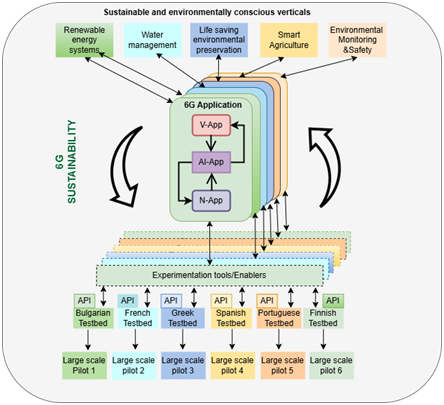6G Pilots
From the AI-driven monitoring and control of distributed renewable energy sources in Bulgaria to the data-centric management of water and waste in French critical infrastructure, each of the 6 pilots is a testament to the potential of 6G to revolutionize the expected environmental challenges. Towards achieving this, 6G-VERSUS realizes a three-step methodology by:
- Transforming the currently existing use cases and services into 6G applications
- Testing and validating the 6G applications of each use-case at the six 6G SNS and non-SNS Experimentation Platforms that are supporting the project, properly enhanced with energy efficiency tools and components,
- Assessing both qualitatively and quantitatively the sustainable impact of each 6G Application per use-case/pilot on the environment, the society, the economy, the industry and the European market.
With the support of six 6G platforms/testbeds across Europe (including both SNS Stream C and non-SNS 6G experimentation infrastructures), located in Greece, Spain, France, Portugal, Bulgaria and Finland, 6G-VERSUS is poised to demonstrate the transformative sustainable impact of 6G for a greener future.
The novelty of the proposed trials lies in the transformation of a typical use case into a 6G Application, i.e. a triplet of distributed but fully interacting software components that together realise an AI-assisted vertical service. Each 6G Application is composed of
- the Vertical App (V-App),
- the Network App (N-App), and
- the AI-assisted App (AI-App).
This triad forms the backbone of the proposed 6G trials, with each component meticulously designed to exploit the technical prowess of 6G networks, while the triadic structure is a leap forward in 6G network architecture, enabling a distributed but seamless flow of information and decision-making processes that optimize both the data and control planes of 6G system, towards achieving a sustainable impact in the service provision plane.
6G-VERSUS Concept

6G Applications
- The V-App is tailored to each pilot’s domain-specific requirements, ensuring that the unique challenges of each use case are met with precision and efficiency. It serves as the user-facing layer, providing intuitive interfaces and real-time data insights for enhanced decision-making.
- The AI-App represents the zenith of the trials’ intelligence layer. The AI-App converges the machine learning algorithms and data analytics to process vast streams of information, transforming raw data into actionable knowledge. This AI-driven core is pivotal in achieving context-awareness, enabling the 6G system to make informed decisions that optimize both service quality and energy usage.
- The N-app is the conduit through which the V-app and AI-app communicate, leveraging native 5G/6G APIs to facilitate seamless data exchange and processing. It acts as the mediator, interpreting the needs of the V-app and the insights of the AI-app to maintain a harmonious balance between the data and control planes.
The proposed concept is centred around the execution of six distinct 6G pilots, each tailored to address specific challenges of next-generation sustainable and environmentally conscious verticals and societal impact:
- Greek Pilot: Employs collaborative robotics for Search and Rescue (SaR) operations, improving response times and safety of disaster response efforts, minimizing human risk and environmental impact.
- Spanish Pilot: Develops immersive telepresence actuators for field operations, reducing the need for physical travel and its associated carbon emissions.
- French Pilot: Implements data-driven strategies for water and waste management in critical infrastructures, enhancing efficiency and reducing environmental footprint.
- Portuguese Pilot: Focuses on creating sustainable and safe port infrastructures, contributing to economic growth and environmental conservation.
- Bulgarian Pilot: Utilizes AI to monitor and control distributed renewable energy sources, optimizing energy production and distribution.
- Finnish Pilot: Innovates with a self-sustainable 5G base station, paving the way for energy-autonomous communication networks.
This concept not only showcases the technical feasibility of 6G applications but also paves the way for their role in sustainable development. The trials are expected to yield valuable insights that will shape the future of 6G technology and its applications, driving innovation towards a more sustainable and prosperous society.